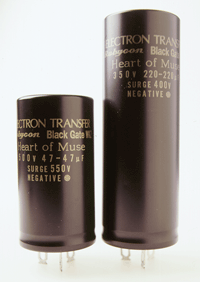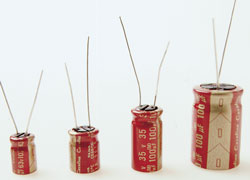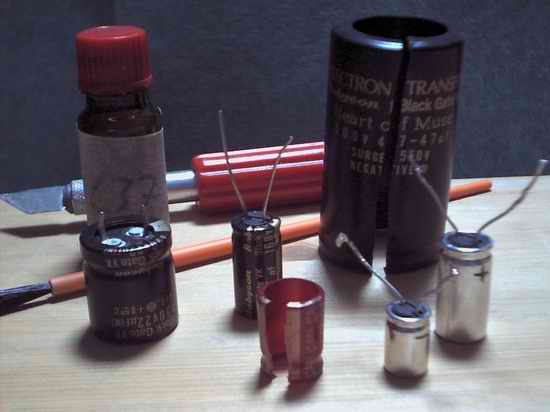Kees Olaf: Capacitor mod 1
 In succes of making our own coupling capacitors (report to be followed), we
have succeeded in upgrading powersupply- and kathode electrolytics! After reading
an article in L'Audiophile about the negative effects in using plastics as dielectric,
we performed some tests on this. We started out with interlinks. We firstly
used an "active" shield to preload the dielectric (9 volt batteries
and 2M2 resistors) in order to try to deminimize the memory effect (aka MDI).
The results of this were, after a few days, astonishing. More and cleaner highs,
better bass and more stagedepth. We also heared that plastics tend to have a
"smearing effect" on sound when used as dielectric. From then on we
avoided those materials when making our own interlinks and wiring (teflon included!)
We were determined in using solely natural materials, like, for instance, PHY-HP
does.
In succes of making our own coupling capacitors (report to be followed), we
have succeeded in upgrading powersupply- and kathode electrolytics! After reading
an article in L'Audiophile about the negative effects in using plastics as dielectric,
we performed some tests on this. We started out with interlinks. We firstly
used an "active" shield to preload the dielectric (9 volt batteries
and 2M2 resistors) in order to try to deminimize the memory effect (aka MDI).
The results of this were, after a few days, astonishing. More and cleaner highs,
better bass and more stagedepth. We also heared that plastics tend to have a
"smearing effect" on sound when used as dielectric. From then on we
avoided those materials when making our own interlinks and wiring (teflon included!)
We were determined in using solely natural materials, like, for instance, PHY-HP
does.
 We started out using different kinds of natural materials like paper, cotton,
etc. all in different ways. One thing led to another and these experiences were
used in making the first series coupling caps. These were much better than factory
made caps!. One thing that remained were those electrolytics as used in
the powersupply and on kathodes... Our favourite in the powersupply is the BlackGate
WKZ and Elna Cerafine on the kathode. On the kathode is BlackGate FK/VK also
good, but the Elna gives more colour to the music..
We started out using different kinds of natural materials like paper, cotton,
etc. all in different ways. One thing led to another and these experiences were
used in making the first series coupling caps. These were much better than factory
made caps!. One thing that remained were those electrolytics as used in
the powersupply and on kathodes... Our favourite in the powersupply is the BlackGate
WKZ and Elna Cerafine on the kathode. On the kathode is BlackGate FK/VK also
good, but the Elna gives more colour to the music..
In an effort to upgrade these caps, we tried the following:
- Plastic cover on the cap was removed: Less harsh, cleaner picture/less grain in mid highs/more colour on instruments/more fine details. Do not forget to mark the negative!
- Aluminum housing C37 treated (two layers); Less "metal harshness", more homogeneous/more open mids/even more colour on instruments.
- Rice paper wrapped around the housing (tightfit); Small preferance in midhighs, little less grain there.
- Replaced the aluminum housing by C37-sealed wooden housing; Now we're talking! This is really good, bigger and deeper soundstage/more open/more bass/really homogeneous/solo instruments are very solid with lots of micro detail/highs are very sibilant/better dynamical response/ better frequency response.

A "how to" report in steps with pics will follow soon. An advise in which wood to use will be included.
Oh yeah! Try this on your own risk!!!
Kees Pel & Olaf Biessen
